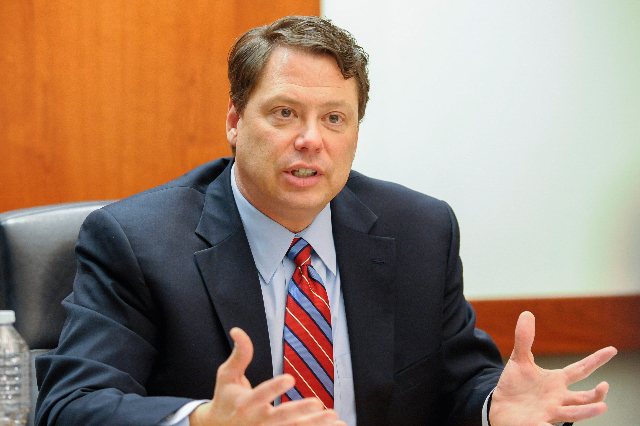Superintendent pitches own plan for splitting school district
Concerns about school segregation, public debt and bureaucratic red tape greeted Superintendent Pat Skorkowsky when he presented lawmakers with a plan to carve the nation's fifth-largest school district into seven smaller precincts.
During the first meeting of an advisory committee charged with reorganizing the Clark County School District, Skorkowsky on Monday pitched a plan that would reshape how his administration oversees individual schools and offer parents more control over their children's education.
"There are opportunities to actually increase our ability to provide quality education, and with (this) impetus, you want to make sure you're taking advantage of those opportunities when you can," Skorkowsky said.
"This gives us the opportunity to make the change at a time when it's important."
His proposal, drafted over the past several months, would create seven so-called instructional precincts based on the existing boundaries of school trustee districts. Sub-superintendents with executive authority over instructional decisions would lead each precinct, with multiple layers of advisory councils providing input to drive more locally based policies and curriculum.
Most operational departments — including human resources, maintenance, food service and transportation — would remain centralized within district headquarters. Magnet schools, English language learner instruction and other specialized programs also would not be subject to precinct control.
Implementation of the plan would begin this month and conclude before the 2016-17 school year. But after lawmakers raised many questions about the fine details of his proposal, Skorkowsky indicated he needed more time to digest their feedback.
"Today was about input, so I will take what was said today (and) determine from there our course of action," he said.
In June, Gov. Brian Sandoval signed legislation that requires the nine-member committee to implement, before the 2018-19 school year, a reorganization plan that increases student achievement, grants more local control and provides cost savings. An independent consultant will help the committee study how the eventual plan impacts school revenue, student demographics, district debt and more.
On Monday, lawmakers focused in particular on the socioeconomic disparities in Skorkowsky's proposal.
In Trustee District D, which overlays much of the city's historic core, an instructional precinct there would serve a student population that is nearly 80 percent Hispanic and more than three-quarters low-income. About one-third of students in that proposed precinct identify as English language learners.
On the southeast side of the valley, however, Trustee District A is less than 23 percent Hispanic, and only 31 percent of students come from low-income families. The English language learner population there is less than 9 percent.
"I'm not entirely convinced that this breakdown is going to ensure something against a pseudo-segregation or de facto segregation approach, even inadvertently, and that concerns me," said Sen. Aaron Ford, D-Las Vegas.
Some of his colleagues questioned whether the instructional precincts actually would have any power to make local decisions, considering Skorkowsky recommended most departments remain at the district-level to keep costs down.
Other lawmakers criticized the precinct structure altogether, wondering what the community gains with more committee meetings, local administrators and bureaucratic red tape.
"The issue has been you have a lot of subcommittees that already function to give findings back to the district or findings back to area superintendents," Assemblywoman Dina Neal, D - North Las Vegas, said. "Sometimes they actually don't give the findings back.
"So that's the communication layer that I'm trying to figure out in this structure."
Skorkowsky countered arguments that his proposal created "more of the same."
In contrast with past efforts to increase student achievement and community engagement with performance zones and regions within the district, Skorkowsky stressed that his plan would offer academic and financial flexibility on local level.
He compared the approach to charter schools or the district's existing turnaround zone, where principals have more discretion and autonomy to recruit highly effective teachers — or fire poorly performing ones — and purchase instructional programs to better serve their unique student groups.
"We need to give that flexibility to those instructional leaders at the school and precinct level to make those decisions, and we have not done that in the past," Skorkowsky said. "That's what we're proposing: The ability to allow them to do that with the funding to support the work that needs to be done."
As for the cost of creating seven precincts, Skorkowsky said he's working to keep the proposal budget neutral.
Beyond appointing a chair and vice chair, the advisory committee did not make any official decisions on Monday. It meets again in late November after a technical advisory committee, which includes local politicians, business representatives and education experts, meet in the first half of the month.
Contact Neal Morton at nmorton@reviewjournal.com. Find him on Twitter: @nealtmorton.



















